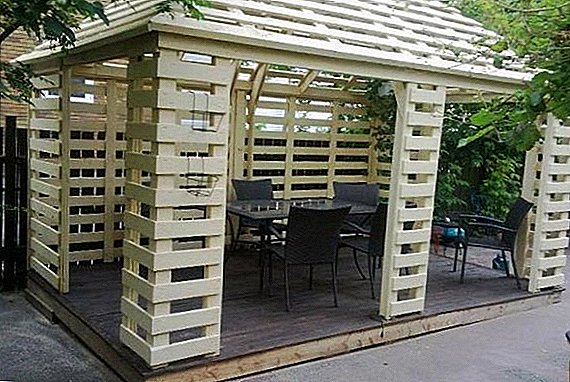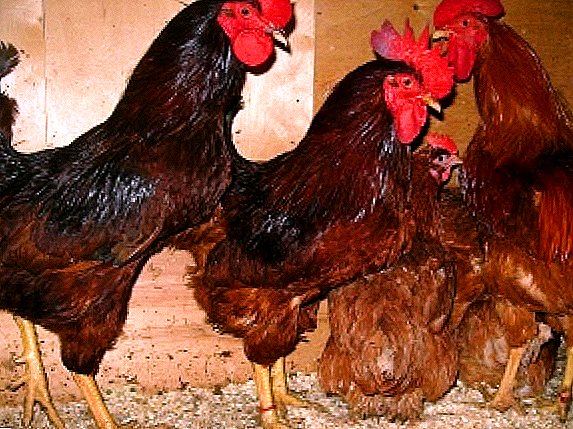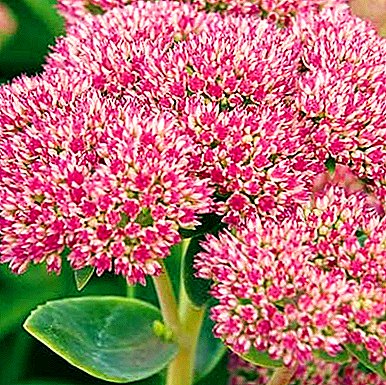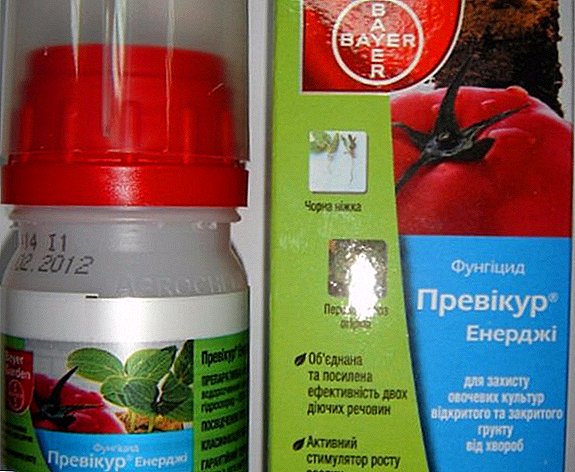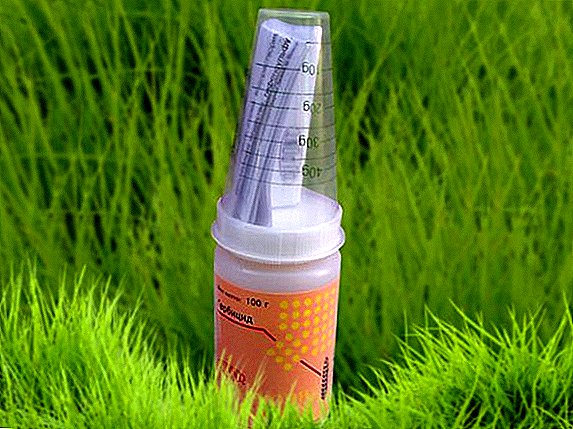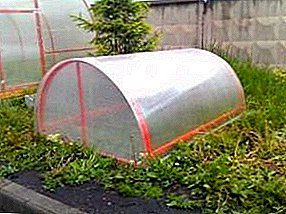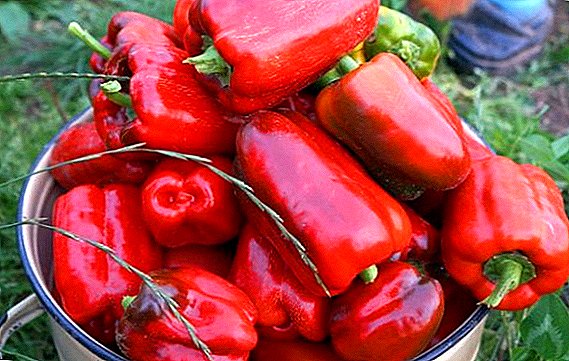 Bulgarian, or sweet, pepper grows every gardener, because it is rich in vitamins and minerals, is an integral part of summer salads and many other dishes. Due to the wide variety of colors, taste and shape, this vegetable has become very popular for cultivation - both at home and in industrial scales. And today we will meet with a very popular variety of sweet pepper "California miracle": with its description, characteristics and how to grow it.
Bulgarian, or sweet, pepper grows every gardener, because it is rich in vitamins and minerals, is an integral part of summer salads and many other dishes. Due to the wide variety of colors, taste and shape, this vegetable has become very popular for cultivation - both at home and in industrial scales. And today we will meet with a very popular variety of sweet pepper "California miracle": with its description, characteristics and how to grow it.
Description and characteristics of large-fruited varieties
The height of the bush "California miracle" is 50-75 cm, and the fruits begin to ripen after 4 months from the time of planting. The fruits of such a pepper have a cubical shape with a similar structure. Weight ranges from 80 to 170 grams, the fruits have fleshy elastic pulp up to 1 cm thick, which is covered with smooth skin. Like most varieties of Bulgarian pepper, when ripe, the fruits have a bright green color, but when the California Miracle ripens, it turns red. It differs from other varieties of pepper by its specific and sweet taste, which makes it possible to use fruits not only in raw form and in salads, but also to be used for stuffing, cooking various sauces, and also for canning.
You will be interested to learn about other varieties of sweet pepper.
Growing conditions
Pepper "California miracle" is demanding to light and heat: if the daylight day is less than 12 hours, early and fruitful fruiting will be stimulated. As for the soil, it should have a neutral acidity. In acidic soil, the plant is more exposed to various diseases. This vegetable may be similar to the conditions for growing tomatoes.
Growing sweet pepper "California miracle"
This vegetable is grown from seedlings. The quality of seedlings depends on the proper planting of seeds, which in turn depends on the amount of the crop and the plant's resistance to diseases, as well as to adverse environmental conditions.  Planting seeds in the open land is not worth it, because you need to sow no earlier than June, when the daily temperature will allow. In this case, the pepper will begin to bear fruit not earlier than the end of August or September, and the quantity of the crop will be very small and of poor quality.
Planting seeds in the open land is not worth it, because you need to sow no earlier than June, when the daily temperature will allow. In this case, the pepper will begin to bear fruit not earlier than the end of August or September, and the quantity of the crop will be very small and of poor quality.
Preparation of planting material
Before planting, seeds need special treatment. They should be soaked in water with a temperature of about 60 ° C for several hours (before the swelling of the planting material). Then the seeds must be removed, wrapped in water-soaked gauze or bandage and left in this form for a period of 2 to 4 days. Such a procedure will speed up seed germination. A few days after the seeds are planted, they will begin to germinate.
Did you know? Sweet pepper and chocolate - completely different products, but there is a common thing between them: their use contributes to the release into the blood of endorphins, better known as "hormones of happiness".
Capacity and soil for seedlings
To grow strong seedlings, the soil must consist of a substrate with high fertility. Such a substrate can be purchased at an agricultural store or you can make one yourself: to do this, mix sand, leaf humus and garden soil in equal parts.  And to protect the "California miracle" from pests and diseases it is recommended to add a handful of wood ash. Many varieties of Bulgarian pepper can not dive, so the seeds are planted in separate pots with a diameter of about 9 cm. The best option for planting will be peat pots. The plant can be planted in the ground with them.
And to protect the "California miracle" from pests and diseases it is recommended to add a handful of wood ash. Many varieties of Bulgarian pepper can not dive, so the seeds are planted in separate pots with a diameter of about 9 cm. The best option for planting will be peat pots. The plant can be planted in the ground with them.
Sowing seeds
The most favorable time for sowing seeds of the California Miracle pepper is the middle of February or its end.
Learn also how to grow vegetables such as potatoes and turnips from seeds.This time is chosen so that by the time the vegetable is planted in the ground, it already has flowering or even fruit ovary. Plant seeds need to a depth of about 2 or 3 cm.
Care and conditions for growing seedlings
After sowing seeds of pepper, it is necessary to pour them well with water, and then cover them with a film; glass can also come up. Before the plant grows, it must be kept in a warm room at a temperature not lower than 21 ° C.
When the plant rises, the optimum temperature for it will be 27 ° C during the day and 13 ° C at night. Do not often water the seedlings, as frequent watering can lead to rotting of the stem and roots. For watering seedlings need to use water, the temperature of which will be slightly higher than the surrounding. In February and March, seedlings need additional light 14 hours a day.
Important! Water for irrigation in any case should not be cold and running, because the plant can get sick and die.The air in the room should be slightly humid, while it is important to spray the room itself, not the plant.

Planting pepper in open ground
Before planting seedlings in the open land, it should be gradually accustomed to environmental conditions. Therefore, it is taken out on the street for several hours every day, increasing the time spent in the fresh air.
Important! The temperature of the air outside during hardening should not be less than 14 ° C in order to avoid hypothermia and the death of the plant.
Seedlings should be planted in open land from late May to mid-June, and if planted in an unheated greenhouse, then this should be done in April. Pepper wells should be 40 centimeters by 40 centimeters. The depth of planting should be equal to that in which the seedlings grew in a cup or box.
If you are going to plant several varieties of pepper in the garden, they should be planted at a great distance from each other, since pereopylenie is peculiar to this vegetable. To avoid it, between different varieties should be planted high crops, such as corn, sunflower.  The landing site of the pepper is also important, or rather, what grew up at this place last year. The best predecessors are cucumbers, onions and carrots. It is impossible to plant in those places where solanaceous crops grew last season, as they feed on the same elements, and this depletes the soil, which will negatively affect the plant.
The landing site of the pepper is also important, or rather, what grew up at this place last year. The best predecessors are cucumbers, onions and carrots. It is impossible to plant in those places where solanaceous crops grew last season, as they feed on the same elements, and this depletes the soil, which will negatively affect the plant.
Care and secrets of growing
Caring for the "California miracle" is no different from caring for other varieties: it consists of timely and proper watering, feeding and pruning of the shoots below the main branching, which is carried out every 10 days and after harvest.
Watering
Pepper "California miracle" is a very moisture-loving plant, when growing which requires frequent watering. Watering should be after each disclosure of the flower. During a drought, watering should be strengthened and carried out only in the morning and evening.
After the appearance of the ovaries, the pepper begins to grow in length, then in breadth, and only then it begins to increase the amount of pulp. During this period, it is especially necessary to pay attention to watering: if the vegetable receives less necessary moisture, the fruits will grow unsaturated and dryish.  But also it is not necessary to flood the plant too much - this can lead to rotting of the roots or lure slugs that feed on both fruits and pepper leaves.
But also it is not necessary to flood the plant too much - this can lead to rotting of the roots or lure slugs that feed on both fruits and pepper leaves.
Did you know? According to the content of vitamin C useful for humans, pepper overtakes even lemon: it is enough to eat half of the vegetable in order to replenish the daily supply of this vitamin.
Features feeding
Plants start feeding from the time when 2 strong leaves appear on the seedlings. For the first top dressing, 0.5 g of ammonium nitrate, 1 g of potassium-based fertilizer and about 3 g of superphosphate are taken for 1 l of water. The following feeding is carried out in 14 days with a double dose of fertilizer.
You will certainly be useful to learn about yeast dressing for pepper.Throughout the season, weekly supplements with a mixture of chicken manure (or mullein) with water in a ratio of 1 to 10 are needed. Between such supplements, it is recommended to spray the plant with water and mineral fertilizers.

Soil care
After each irrigation, the soil should be loosened (aerated) at a depth of up to 8 cm so that the earth does not harden. In a particularly hot time, it is necessary to produce mulching of pepper with a straw that is more than 10 cm thick. These procedures will help protect the soil from drying out and retain moisture for the pepper.
Harvest
The first harvest is carried out in July, but if the seeds were planted immediately in open ground, then it starts in August and lasts until the onset of frost. The harvest of the "California miracle" is carried out with the onset of biological ripeness, when the pepper has fully ripened and acquired all its varietal qualities, as well as the onset of technical ripeness, when the fruit has formed a shape and optimum size, but has not acquired the characteristic red color and taste.
Such ripeness can be determined by the crunch when touching a vegetable. Often the fruits are harvested with the onset of technical maturity - this allows longer to store the vegetable.  Fruits that have matured, both biologically and technically, should be cut with the leg: thanks to this, the shelf life is increased. Harvesting is necessary on time - if you are late with the harvest, there may be no second harvest.
Fruits that have matured, both biologically and technically, should be cut with the leg: thanks to this, the shelf life is increased. Harvesting is necessary on time - if you are late with the harvest, there may be no second harvest.
Important! The harvest should be fully harvested before the onset of frost, otherwise the fruit will not be subject to any storage and will rot very quickly.In conclusion, I would like to say that a large and tasty harvest of California Californian pepper depends on properly grown seedlings, as well as proper care of the plant throughout the summer season.



